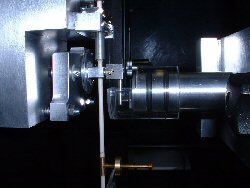Apr 26 2008
Micro Materials have been making innovative nanoscale test instrumentation for more than twenty years. Centre to their range is the NanoTestT platform which offers options to study a wide variety of materials properties. While many systems have made measurements under ambient conditions, Micro Materials have recognized that environmental testing is key when evaluating true "in-use" performance characteristics.
 Image of the Micro Materials fluid cell mounted in the NanoTestT.
Image of the Micro Materials fluid cell mounted in the NanoTestT.
Mechanical properties of biological and polymeric samples often vary considerably when in a fluid environment compared to the usual dry testing conditions. If a rsearcher wishes to understand their properties and behaviour in fluid media, it is highly desirable to test under these conditions rather than to attempt to infer from measurements on dry (or 50% relative humidity) samples. To meet this need, the testing capability of the NanoTestT has been extended by the development of a fluid cell allowing nanoindentation, nano-scratch and nanowear testing of samples fully immersed in fluids. This development builds on the earlier success of the NanoTestT humidity control chamber which allows testing under 25-90% RH. The fluid cell works with the existing pendulum design and the horizontal loading has several key advantages for testing in fluid.
This was recognised by users around the world such as Krystyn J. Van Vliet, Lord Foundation Assistant Professor, MIT Department of Materials Science and Engineering. For her work, she says "this liquid cell feature has enabled us to explore the mechanical properties of hydrated materials, which is particularly important to our studies of biologically relevant and biodegradable surfaces and which are not accessible to us through other instrumentation with comparable ranges of calibrated force and depth."
Pushing the capabilities of nanoscale testing combining imaging and nanomechanical measurement is offering users greater scope to characterize materials whether in the bio or materials sciences.